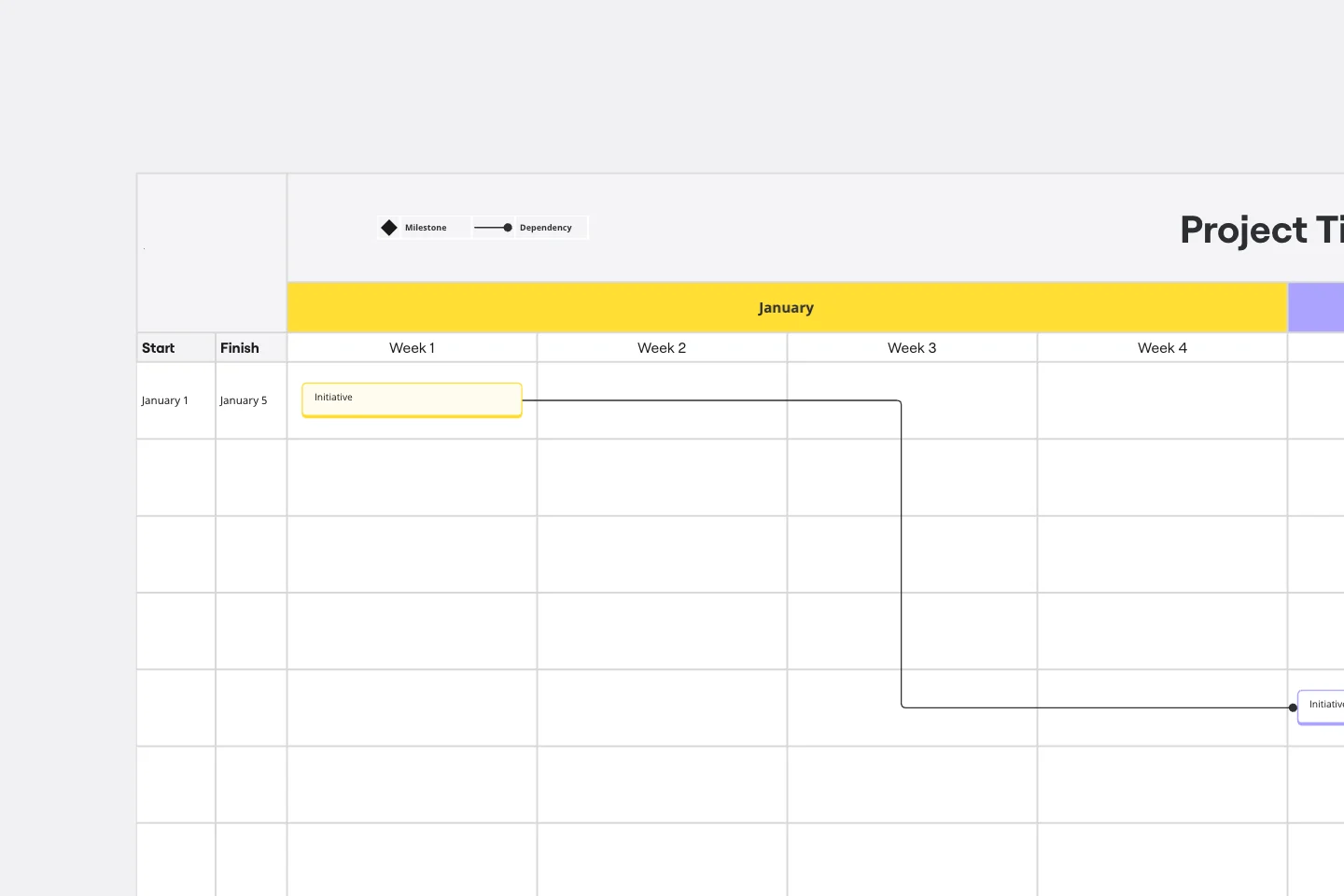About the Timeline Workflow Template
A timeline is a visual tool that chronologically plots out projects step by step. It’s an ideal tool for your team to tell stories (such as an overview of events in your organization), and visualize your projects or processes.
When to use the timeline workflow template
The timeline workflow template is perfect for any project that relies on visual content. You may find it beneficial to use with your team and also to share with other stakeholders or clients to keep them in the loop on your progress.
The benefits of using timelines
Timelines are extremely effective tools for teams, whether distributed, in the office, remote, or all of the above. Here are four key benefits.
Alignment: Timelines empower teams to stay aligned throughout the lifecycle of a project, so everyone knows their responsibilities and nothing falls through the cracks.
Planning: Teams use timelines to establish the scope and parameters of a given project. Timelines help you articulate the resources you’ll need to finish the project, project stakeholders, and important deadlines.
Visualization: When you’re working on a project with many moving parts, it can be difficult to figure out your responsibilities to the team. Timelines help your team visualize, track, and report on your progress, as well as past and future steps toward finishing your goal.
Ownership: Timelines allow team members to take ownership of their responsibilities. When you’ve mapped all required deadlines and tasks into a timeline, you can then use the timeline to assign roles and responsibilities. Everyone can then refer to the timeline to understand who owns each aspect of the project.
Create your own timeline workflow
Miro is the perfect canvas to create and share your timeline workflow. Get started by selecting this timeline workflow template.
Add teammates or stakeholders to the timeline board. Customize accordingly to make the timeline representative of your project, filling in the following sections to keep track of everything in one place:
Completed
Unassigned
In progress
References
Deliverables
Discover more workflow diagram examples and propel your projects forward.

Miro
Your virtual workspace for innovation
Miro is an innovation workspace designed for teams of every size, everywhere, to dream, design, and build the future together. Our mission? To empower these teams to create the next big thing, powered by AI at every step of the way. Over 90 million users around the world rely on Miro to untangle complex ideas, put customer needs first, and deliver products and services faster. All supported by best-in-class security, compliance, and scalability.
Categories
Similar templates
Workflow Template

Workflow Template
The digital world requires collaboration, and better collaboration leads to better results. A workflow is a project management tool that allows you to sketch out the various steps, resources, timeline and roles necessary to complete a project. It can be used on any multi-step project, whether it’s a business process or otherwise, and is ideal for plotting out the tangible actions you’ll need to take to achieve a goal and the order in which you need to complete those actions.
Product Roadmap Template

Product Roadmap Template
Product roadmaps help communicate the vision and progress of what’s coming next for your product. It’s an important asset for aligning teams and valuable stakeholders – including executives, engineering, marketing, customer success, and sales – around your strategy and priorities. Product roadmapping can inform future project management, describe new features and product goals, and spell out the lifecycle of a new product. While product roadmaps are customizable, most contain information about the products you’re building, when you’re building them, and the people involved at each stage.
Gantt Chart Template

Gantt Chart Template
Simplicity, clarity, and power — that’s what make Gantt charts such a popular choice for organizing and displaying a project plan. Built upon a horizontal bar that represents the project progress over time, these charts break down projects by task, allowing the whole team to see the task status, who it’s assigned to, and how long it will take to complete. Gantt charts are also easily shareable among team members and stakeholders, making them great tools for collaboration.
Workflow Template

Workflow Template
The digital world requires collaboration, and better collaboration leads to better results. A workflow is a project management tool that allows you to sketch out the various steps, resources, timeline and roles necessary to complete a project. It can be used on any multi-step project, whether it’s a business process or otherwise, and is ideal for plotting out the tangible actions you’ll need to take to achieve a goal and the order in which you need to complete those actions.
Product Roadmap Template

Product Roadmap Template
Product roadmaps help communicate the vision and progress of what’s coming next for your product. It’s an important asset for aligning teams and valuable stakeholders – including executives, engineering, marketing, customer success, and sales – around your strategy and priorities. Product roadmapping can inform future project management, describe new features and product goals, and spell out the lifecycle of a new product. While product roadmaps are customizable, most contain information about the products you’re building, when you’re building them, and the people involved at each stage.
Gantt Chart Template

Gantt Chart Template
Simplicity, clarity, and power — that’s what make Gantt charts such a popular choice for organizing and displaying a project plan. Built upon a horizontal bar that represents the project progress over time, these charts break down projects by task, allowing the whole team to see the task status, who it’s assigned to, and how long it will take to complete. Gantt charts are also easily shareable among team members and stakeholders, making them great tools for collaboration.